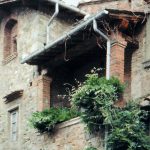Located on the hill at the eastern end of the village, the Rocca or fortress of Laterina was destroyed and rebuilt several times during the struggles between the people of Arezzo and Florence.
Since 1272, the lord of Laterina was Bishop Guglielmino degli Ubertini, and in 1288, during their war against Arezzo and the Ghibelline nobles of the countryside, the Florentines destroyed various castles. It was only in 1298 that they completely rebuilt the Rocca. However, with the return of the Ubertini in 1304, Laterina came back under their control, and they governed it on behalf of Arezzo. The well-known political conflict between the Ubertini and the Tarlati had its repercussions, and in 1326, the Ubertini conspired against the powerful bishop and new lord of Arezzo, Guido Tarlati. In response, Tarlati besieged and destroyed Laterina. However, even this family would not be able to withstand the overwhelming expansionist policy of the Florentine mercantile Guelf Republic. As early as 1336, Buso degli Ubertini, the new bishop of Arezzo, placed Laterina under the protection of the Florentines, who once again rebuilt the strategic Rocca and its walls.
Today, only some remnants of the 14th-century fortifications remain, including tall walls around the south-western corner. In the early 20th century, it belonged to the Deaglio family, who created a vaguely neo-medieval layout around the ancient ruins, featuring a small brick loggia with pointed arches, some single windows, a well, romantic Guelph battlements, scenic staircases, statues, terracotta vases, and a formal neo-Renaissance garden with boxwood hedges, in line with the fashions of the time. Since the 1950s, it has been owned by the Baglioni family. The complex is not open to the public.









